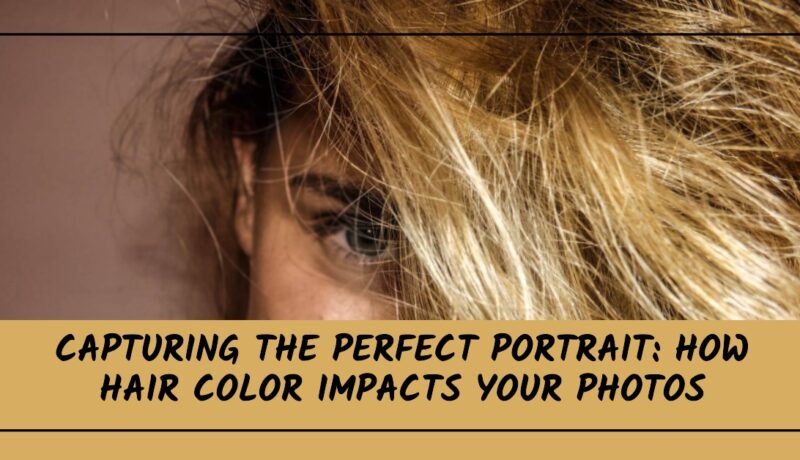The Influence of Hair Color on Portrait Photography

Are you ready to dive into the vibrant world of portrait photography?
Join us as we unravel the captivating influence of hair color on the art of capturing moments. Like a brushstroke on a canvas, hair color shapes the composition, mood, and emphasis in a portrait.
It creates contrast, enhances skin tones, and even influences wardrobe choices.
From emphasizing facial features to conveying personality, hair color is a powerful tool.
So, let’s embark on this artistic journey and explore the mesmerizing impact of hair color in portrait photography.
Contrast and Composition
To create depth and visual interest in your portrait photography, consider using hair color to juxtapose against the background and enhance the overall composition of the image.
Lighting techniques play a crucial role in highlighting the contrast between the subject’s hair color and the background. By strategically placing light sources, you can accentuate the vibrant hues or subtle tones of the hair, creating a dynamic and captivating visual effect.
Additionally, background selection is key in achieving a harmonious composition. A dark background can make light-colored hair stand out, while a light background can provide a striking contrast for dark hair. Color theory also comes into play when utilizing hair color for contrast. Complementary colors, such as blue and orange or purple and yellow, can create a visually appealing balance in the photograph.
Hair accessories can further enhance the composition by adding texture and interest to the overall image. From barrettes to headbands, these accessories can be used to complement or contrast with the subject’s hair color, adding another layer of depth and creativity to the portrait.
Skin Tone
When considering the influence of hair color on portrait photography, it’s important to acknowledge the impact it can have on the subject’s skin tone. Hair color can either enhance or detract from the natural complexion of the subject, making it a crucial factor to consider in achieving a harmonious and flattering look.
Makeup techniques play a key role in balancing the skin tone with the chosen hair color. For example, if the subject has warm undertones with red hair, using makeup with cool undertones can help create a pleasing contrast. Lighting considerations also come into play, as the right lighting setup can highlight the subject’s skin tone and hair color in the most flattering way.
Hair Care tips are essential for maintaining the vibrancy of the chosen hair color. Proper care and hair conditioning can help prevent fading or discoloration, ensuring that the hair color remains consistent and enhances the subject’s overall appearance.
Color theory also plays a significant role in determining the right hair color for a subject’s skin tone. Understanding complementary and contrasting colors can help create a visually appealing and balanced portrait.
Lastly, hairstyling options can further enhance the subject’s skin tone. The right hairstyle can frame the face and draw attention to the skin, creating a cohesive and aesthetically pleasing portrait.
Wardrobe and Styling
Consider the subject’s hair color when selecting wardrobe and styling elements for a portrait. Color coordination is crucial in creating a cohesive and visually appealing composition. Take into account the subject’s hair color when making fashion choices, as certain colors can either enhance or clash with their hair. It’s important to select clothing and accessories that complement the hair color, creating a harmonious overall look.
When it comes to makeup techniques, the subject’s hair color can influence the choices made. For example, a redhead may benefit from warm-toned makeup to enhance their vibrant hair color, while a person with dark hair may opt for more dramatic makeup to create a contrast. Additionally, hair styling can be used to enhance the subject’s hair color, whether it’s through voluminous curls or sleek and straight styles.
Accessory selection is another key aspect to consider. Accessories can be used to accentuate the subject’s hair color and overall appearance. For example, a hairpin or headband in a complementary color can draw attention to the hair, while statement earrings can add a touch of glamour.
Emphasis on Features
Hair color can highlight specific facial features in portrait photography. When choosing a hair color for a portrait, photographers often consider how it can be used as a focal point to draw attention to certain areas of the face. Light hair, for example, can accentuate the eyes and eyebrows, creating a captivating effect. Dark hair, on the other hand, can add drama and focus to the jawline or lips, enhancing the overall facial structure. By framing the face with the right hair color, photographers can create depth and dimension in their portraits.
Moreover, hair color can also play a crucial role in highlighting facial expressions. Bright and vibrant hair colors can convey a sense of energy and playfulness, while natural and muted tones can evoke a more serene or timeless mood. By aligning the hair color with the desired expression, photographers can enhance the emotional impact of their portraits.
Mood and Personality
Your choice of hair color in a portrait can greatly influence the mood and personality conveyed in the photograph. Hair color has a strong association with symbolism and psychology, making it an important aspect of self-expression. Different hair colors evoke distinct emotions and traits, allowing the subject to project their desired personality.
For example, vibrant and unconventional hair colors like blue or pink can convey a sense of creativity and individuality. On the other hand, natural hues like brown or blonde can create a more classic and timeless look, suggesting elegance and sophistication.
Hairstyling techniques also play a role in enhancing the mood and personality of the portrait. For instance, voluminous curls can add a sense of playfulness and energy, while sleek and straight hair can portray a more polished and professional demeanor. Additionally, trends in hair color can influence the overall aesthetic of the photograph. Keeping up with current hair color trends can help create a modern and fashion-forward look, while opting for a more traditional color can evoke a sense of nostalgia.
Understanding the psychology behind hair color is crucial in capturing the desired mood and personality in a portrait. Warm colors like red or copper can evoke feelings of passion and vitality, while cooler tones like silver or ash blonde can create a sense of calmness and serenity. Lastly, hair color can be a powerful tool for self-expression, allowing individuals to showcase their unique personality and style through their chosen color.
Post-Processing
When it comes to post-processing in portrait photography, adjustments to color balance and tone can be made to enhance or modify the appearance of the subject’s hair color. Editing techniques such as color grading and selective adjustments can be used to bring out the vibrancy and richness of the hair color, resulting in a more visually appealing image.
Color balance refers to the overall distribution of colors in an image, and it can be adjusted to ensure that the hair color appears true to life. Tone adjustments, on the other hand, involve altering the brightness and contrast of the hair color to create a desired effect. By carefully manipulating these elements, photographers can enhance the natural beauty of the subject’s hair or even completely transform its color.
Whether it’s enhancing the warm tones of red hair or modifying the cool tones of blonde hair, post-processing allows for endless creative possibilities in capturing and showcasing the unique characteristics of each individual’s hair color.
Cultural and Social Significance
As you delve into the realm of cultural and social significance in portrait photography, it’s essential to consider the influence that a subject’s hair color can have on conveying a sense of identity and belonging. Hair color symbolism plays a significant role in cultural representation and social identity. Different hair colors are often associated with specific cultural or subcultural groups, and they can serve as a visual cue to the subject’s background, heritage, or personal style.
However, it’s important to recognize that hair color stereotypes should be challenged, and diversity in hair color should be celebrated. It isn’t only about conforming to societal expectations or fitting into a predetermined notion of beauty; rather, it’s about embracing individuality and promoting inclusivity.
In portrait photography, the choice of hair color can be a deliberate artistic decision that goes beyond simple aesthetics. It can be a means of empowering the subject, allowing them to express their true selves and celebrate their unique traits. By capturing and highlighting the diversity in hair color, photographers can contribute to a broader narrative of acceptance and appreciation for all types of beauty.
Conclusion
In conclusion, the influence of hair color on portrait photography is undeniable. Like a brushstroke on a canvas, it adds depth and contrast, enhancing the overall composition. Just as colors blend and harmonize, hair color interacts with skin tones, wardrobe choices, and styling decisions.
It becomes a tool for emphasizing features, conveying mood and personality. Post-processing allows for further enhancement or modification, like a skilled painter touching up their masterpiece. Ultimately, hair color holds cultural and social significance, providing a sense of identity and belonging to the subject and the photograph itself.
